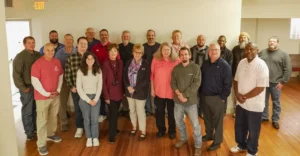
Robert Hawkins has been a cattleman for as long as he can remember–his entire life actually. He grew up on a farm and when his father died suddenly while Robert was still a teenager, he carried on the operation with his brother until he was old enough to run the farm on his own. Robert is also in the construction business, but for the purposes of this article, we focused on his skills as a cattleman.
Raising cattle is a long-term commitment. I know because I grew up on a farm and have some personal experience with what is required when your livelihood depends on how the livestock are doing. It strikes me that there are certain characteristics that define a successful farmer that may be common to a great relationship. I asked Robert, “What do you think a cattleman requires? What kind of person does he need to be?”

Take the Long-Term View.
The first thing Robert mentioned was patience. He said, “If you don’t make any big mistakes, things usually get better in the long run. You need to be a long-term planner.” Robert certainly took his own advice when he met and married Kim. They first met when she was a “skinny little 12-year-old” and he was a teen five years older. “We teased her and made fun of her then,” he said, but later on he clearly changed his mind. The two of them have been a couple for 30 years and married for 24.
“You’re going to have a bad day, month, or year every once in a while,” he remarked, “I only plan on making a profit 3 out of 5 years.”
Now there’s some great advice for a good relationship. Take your time. Be patient. Let things work themselves out. I wonder what a difference it would make if we applied the 3/5 ratio to our marriages. Of course we want it to be sunshine and roses every day, but that’s just not realistic. There are those moments, those days, and sometimes even longer when it’s necessary to take the long-term view in life and love. Cattlemen know this. We do well to remember it too.

A compatible partner is key.
“It’s hard to survive without a good partner. In farming, she’s not just my wife, she’s a vested partner, a hired hand, and more. We each have multiple roles.” With this statement, Robert clearly demonstrates his understanding of the importance of “making the right choice,” i.e., taking the time to find a compatible person who shares the same interests. Robert loves farming and he loves Kim all the more because she does too. Had he not chosen carefully, the two of them might be miserable. Even so, sharing this love would not be enough if either of them were tied into rigid role expectations. Allowing Kim the freedom to do a number of things and fulfill a variety of roles is key to their happiness.

Have similar values.
It’s one thing to love the idea of country life. It’s quite another to actually live it. According to Robert, this is the utmost in importance. He related a recent icy weekend when they had seven calves born during an ice storm. “We were both up until midnight—wet, cold and exhausted—and just happy as could be that we didn’t lose any calves. And then, we still had to get up and go to work the next day.”
“I think it was one of the moments when you realize you married the right woman–when she milks a wild cow to help a baby calf survive. . . . Kim was a city girl who always wanted to be a country girl. The first time I had to help a fallen calf I knew I had struck gold, because she had afterbirth up to her armpits and was as happy as a clam.”
I wish more couples would give the significance of shared values serious consideration when they are contemplating marriage. Share the same interests and values and you have, as Robert says, “struck gold.” It’s not enough to find each other fun and attractive. It’s much more important that you embrace the same values and beliefs. That’s infinitely more likely to get you through a lot of cold and snowy nights out in the barn– or other difficult places where couples might find themselves.
“Good Stock“
A good cattleman looks for the proper genetic characteristics. Robert has approximately 100 head herd of the Beefmaster breed. This particular breed was developed by a Texas rancher who combined the Shorthorn, Hereford and Brahman breeds to get the characteristics of cattle that do well in cold winters and the hot, humid summers of Texas, Oklahoma and Missouri. In a similar way, if you want someone who will share similar interests and values, it’s important to look for “good stock,” i.e., someone with strong character and good family values.

Robert agrees. “This makes a big difference when you raise children together. We could have sold our farm years ago, but we could not think of a better environment in which to raise our sons. We have raised three very responsible and well-adjusted young men.”
At the same time, this doesn’t mean that Robert and Kim think of and react to the world in exactly the same way. “Kim is a super-sensitive lover of life and she has a very hard time accepting the death of an animal. I’m an old callous cowboy with the idea that ‘things die.’ She thinks I’m insensitive at times. When we lose an animal, she takes it hard. We approach things differently. I need to remember this.”
I love the way these two think. Perhaps that’s why they’ve been such good hosts and role models for other couples–young and old. Together they bring a measure of tenderness and toughness that makes them hard to resist.

In summing up what he knows about farming and relationships, Robert had a few closing thoughts. “Learn to pick your battles,” he said, “in business, farming, and relationships. I don’t fight every situation. On a farm, there’s always so much work to do that you have to choose what matters most, like good fences, the health of your cattle and so on. You deal with weeds, rocks, etc. later. We’re very open. We’re not afraid to talk. We bring it out. There’s no skeletons. We concentrate on what is key to success in life and love and get to the rest when we can.”
I knew I liked Robert the first time I met him. Now I know why. He has a great handle on what’s important in life and how to keep the main thing, the main thing. Plus, he married a wonderful woman.
Call me grateful for two terrific role models,
Dr. Jennifer L. Baker




